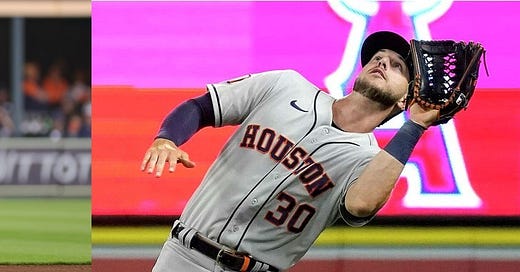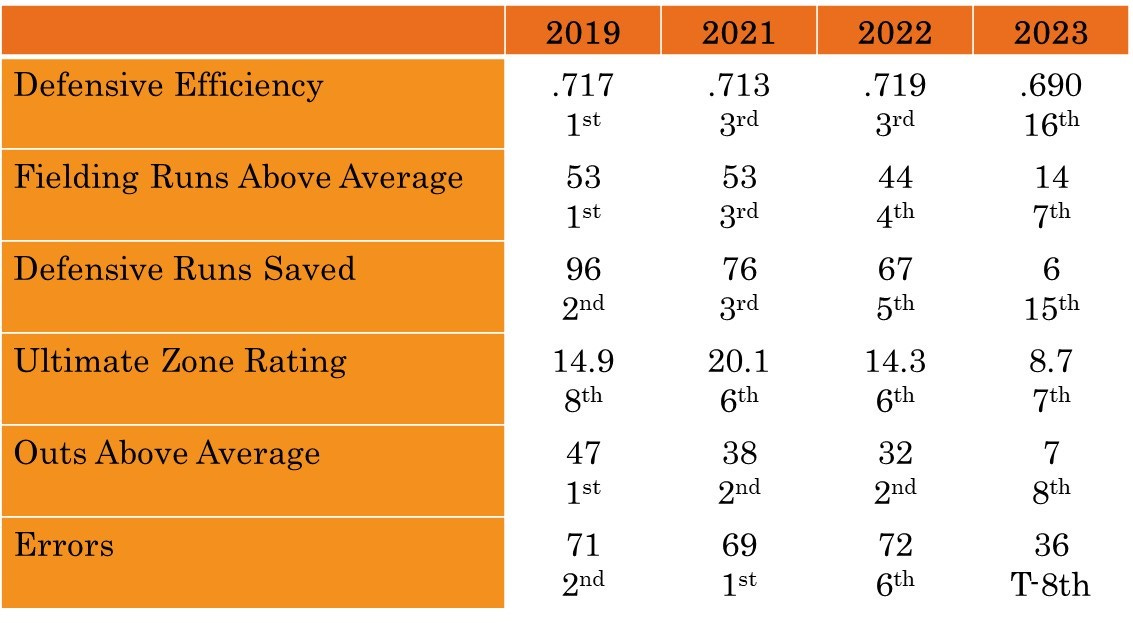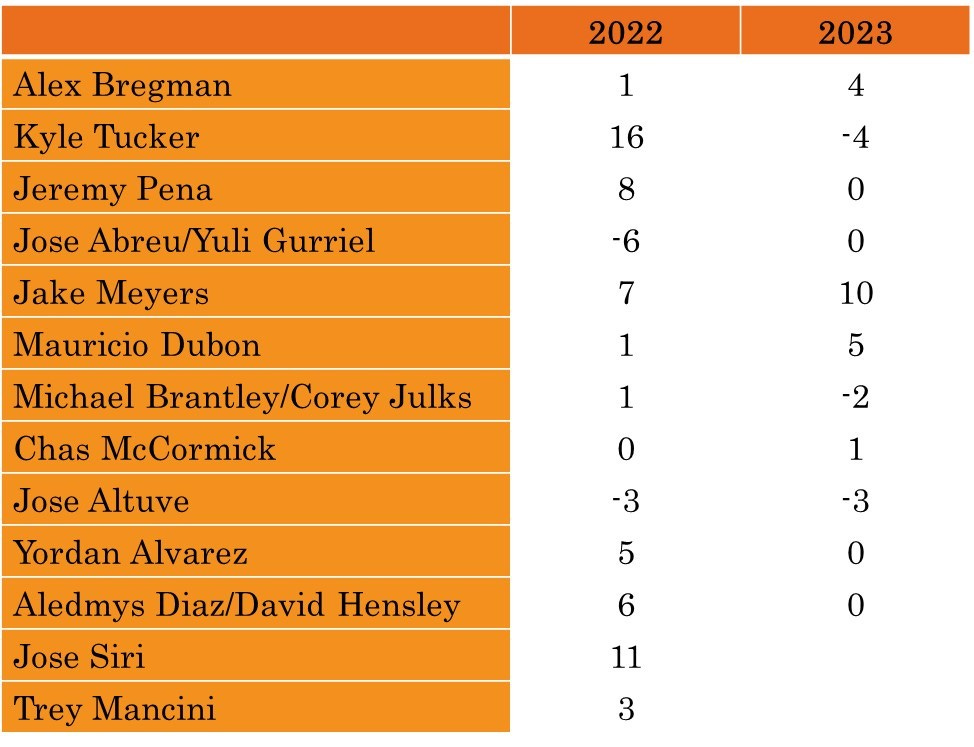The Astros Defense Has Declined, Especially Among Its Best Defenders
The Astros have had a top tier defense in recent years. But declines in the field, especially by Jeremy Pena and Kyle Tucker, have led to fewer outs and more runs.
After 78 games in the 2022 season, the Astros record was 51-27. This year, it’s 9 games worse at 42-36.1 After 78 games in 2022, the Astros were 13.5 games up on the rest of the AL West. This year, they are five games back of the division lead.
In short, the team has declined this season. Which is not big news. Discussions of the 2023 Astros have focused heavily on different aspects of the decline. Injuries to the starting rotation have compelled the team to rely on the Sugar Land rotation at Minute Maid Park. The decline of the offense inspired a whole post from me earlier this month. Discussion of bullpen woes consumed much of our discussion earlier today on the Go Go Astros podcast.
But I write to highlight one more area where the Astros have declined from their 2022 form—on defense.
The chart below shows the the Astros numbers for different defensive metrics for the last four full seasons. To help put these numbers in context, I included the Astros rank among MLB teams below the number itself.
Defensive metrics are notoriously finicky and are often in conflict. But the pattern here is pretty clear. After being one of the top handful of defensive teams in baseball from 2019 through 2022, the Astros have regressed with their gloves in 2023.
The easiest way to see this is through Defensive Efficiency, which is the simplest of these statistics. It measures the share of balls hit into field of play that are turned into outs. For the 2019, 2021, and 2022 seasons, the Astros turned over 71% of the balls that opponents hit into outs. They were the best team in baseball at defensive efficiency in 2019 and the third best in 2021 and 2022. This season, the Astros are decidedly mid-tier at turning batted balls into outs. They are 16th best in the Majors, turning 69.0% of balls in play into outs.
One can see similar declines in Fielding Runs Above Average, Defensive Runs Saved, and Outs Above Average. The exception is in Ultimate Zone Rating, which has had the Astros as the 7th best team in the majors this season, above the other metrics, after being below them in the previous seasons.
Which Players Are Responsible for the Defensive Decline?
Team statistics are of course the aggregation of the play of individual players. So the defensive decline should be reflected in the decline of individual players.
The table below shows the Defensive Runs Saved in 2022 and 2023 for Astros players (excluding catchers) sorted by their number of defensive innings in 2023. I’ve combined the lines for the same roster spot (e.g. Jose Abreu & Yuli Gurriel).
The chart shows few places where the Astros have improved defensively in 2022—Alex Bregman, Mauricio Dubon, and Jake Meyers all have better defensive numbers in the 2023 half-season than they did over the course of the entirety of 2022. Players like Chas McCormick and Jose Altuve are registering similar defensive numbers this year as compared to last year.
The Astros have also suffered because some players who recorded good defensive numbers for the team in 2022 have moved on. Aledmys Diaz, Trey Mancini, and Jose Siri all helped the defensive effort in 2022, but have taken their gloves elsewhere.2
But there are two players who are heavily responsible for the team’s defensive decline—Kyle Tucker and Jeremy Pena. The two of them were credited with a combined 24 Defensive Runs Saved in 2022. Both won Gold Gloves. But this season, they have a combined -4 Defensive Runs Save, a 28 run decline. It’s a massive decline for the two of them, defensive anchors in 2022.

Chandler Rome explored Tucker’s defensive slump in May at The Athletic. In the article, Astros coach Gary Pettis said that Tucker “has a tendency sometimes to stand flat-footed with no movement pre-pitch. When he does that, sometimes he breaks maybe a second later than he normally would. That’s all it is, really, with him, it’s whether he’s on time or not.”
Pettis attributed Tucker’s defensive slump to “the timing aspect of the ball being in the hitting zone and him anticipating when it’s there, maybe it’s just a little bit off right now. He’s working on it and I think he’ll get back to the Kyle Tucker we’re used to seeing.”
And at some level, Pettis was correct. When the article was published on May 23, Tucker had -7 Defensive Runs Saved. So he has improved that number since then.
But even with the improvements in the last month, Tucker has declined defensively. So has Pena, who has turned in an average defensive performance this season.
It is likely that these declines by Tucker and Pena are simply just slumps. Just as batters can have a bad stretch at the plate and it shows up in their offensive numbers, so can fielders. Tucker and Pena have given lots of evidence that their usual level of defensive play is better than what we have seen in 2023. As noted, we have already seen some improvement from Tucker.
But in a playoff race that will likely come down to a couple of games, getting the Astros defense back to the levels we have seen in previous seasons would go a long way to getting the Astros out of their current doldrums.
Yes, they are still over .500. It only feels like they are 20 games under.
Though it should be noted that all three of these players have also regressed defensively in 2023, so keeping them would not have necessarily improved the defense.





